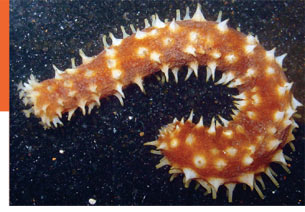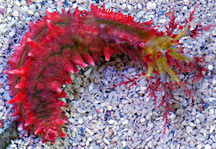Echinoderms: Part 6 - Sea Cucumbers (Holothuroidea)
Michael Paletta - Guest Author
These animals live in virtually all oceans and can be found in many varied environments from soft muddy or silty areas to hard or sandy areas. They have evolved so that different species take advantage of different substrate type. Some species even live within the live rock itself and gnaw through this hard substrate to obtain food. Regardless of which type of substrate they live in, sea cucumbers all excrete pellet shaped fecal matter after they process the substrate. These pellets are comprised entirely of substrate since virtually all the organic matter is meticulously removed from the substrate as it passes through the intestines of the cucumber. Once these pellets are expelled, they rapidly lose their pellet shape and fall apart, returning to the substrate.
Impressively, some cucumbers can reproduce asexually by simply dividing apart. In a couple of species, this division will manifest itself by the mother animal first developing a small appendage on its side. This appendage will gradually grow and after a few weeks it will look like a mini-replica of the mother animal. Eventually it will drop off and become a fully developed cucumber. These animals also reproduce in the usual manner releasing eggs and sperm into the open water. The larvae are free-swimming at first and then develop into juveniles that crawl along the substrate. All sea cucumbers have the potential to poison an aquarium by ejecting their digestive tract and releasing a toxin. Though the toxin is used only for defense, extreme care should be taken when keeping these animals. If you choose to keep these animals, it is ideal to house them in a separate dedicated aquarium free of powerheads and other apparatus on which they could get caught. Other than this aspect, sea cucumbers are quite peaceful and perform a very necessary task in an aquarium. Part 5 of 8. Continue reading:
Biography Michael Paletta is the author of two books, "The Modern Marine Aquarium" and "Ultimate Reefs," and has acted as a consultant with the National Aquarium in Baltimore and the Pittsburgh Zoo Aquarium. |
|||||||||||
|
|







